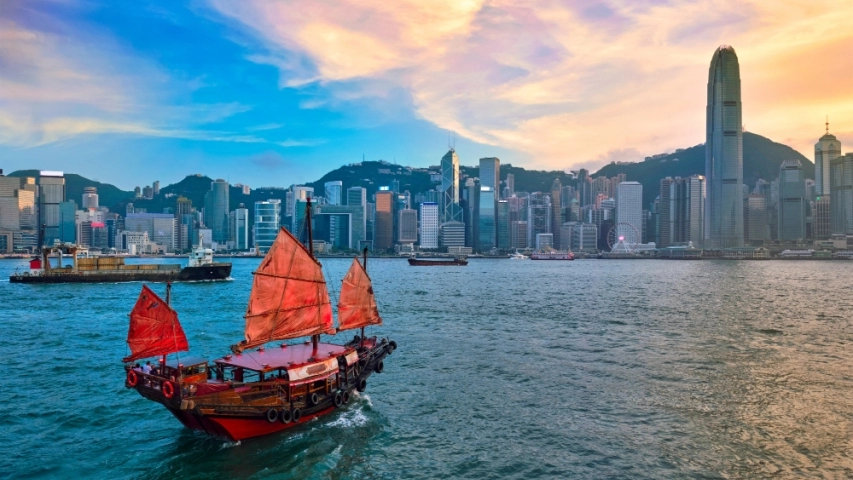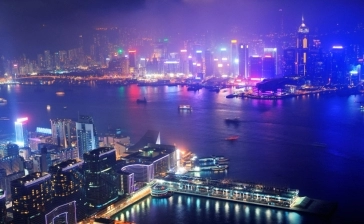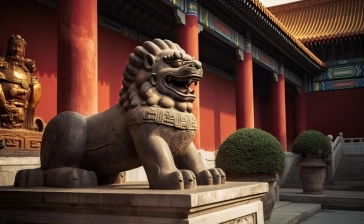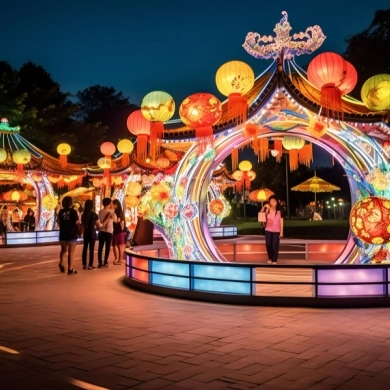Hong Kong, an autonomous territory and a former British colony in southeastern China, is now recognized as a special administrative region of China. This captivating destination seamlessly blends the modern with the traditional. Its bustling, densely-populated urban center stands as a vital port and global financial hub adorned with skyscrapers, lively markets, breathtaking landscapes, and a profound historical heritage.
Despite being famed for its vertical cityscape, filled with hills and stairways, Hong Kong has made significant strides in recent years to enhance accessibility for those with mobility challenges, including wheelchair users. Its central district boasts iconic buildings like the I.M. Pei's Bank of China Tower. Moreover, Hong Kong is a prime commercial hotspot. Key attractions include:
Victoria Bay: A hallmark of Hong Kong, it provides a stunning view of the skyscrapers on Hong Kong Island and Kowloon. The wheelchair-friendly Tsim Sha Tsui promenade in Kowloon is the perfect spot to relish these views, especially during the daily 'A Symphony of Lights' show.
Victoria Peak: The highest point on Hong Kong Island, it offers panoramic city views. While the summit might not be wheelchair accessible, the shopping center at the Peak Tram's upper station is, showcasing mesmerizing vistas.
The Giant Buddha and Po Lin Monastery: Located on Lantau Island, the Giant Buddha is among the world's largest Buddha statues, situated near the Po Lin Monastery. The surrounding area is wheelchair accessible, though a tad steep in parts.
Ocean Park: A beloved theme park in Hong Kong. While not every attraction is wheelchair-friendly, many are, and the park offers an accessibility map detailing which areas are.
Useful Information and Tips:
- Currency: The official currency is the Hong Kong dollar (HKD).
- Time Zone: Hong Kong is UTC +8.
- Dialing Code: (+852)
- Weather: Summers can be hot and humid, so hydration and sun protection are vital.
- Cuisine: A fusion of Cantonese, Japanese, British, and other global cuisines. A must-try is the dim sum – steamed snacks served in bamboo baskets.
- Public Transport: Highly efficient and largely wheelchair-friendly. Most MTR (metro) stations offer step-free access and elevators. Franchise buses and some mini buses have wheelchair ramps and designated spaces. The Star Ferry between Hong Kong Island and Kowloon is also wheelchair accessible.
- Taxis: A convenient mode of transport. A limited number of wheelchair-friendly taxis can be pre-booked.
- Sidewalks: Many have curb cuts for wheelchair users. However, older or busier areas can be challenging to navigate. Tactile paving assists the visually impaired but can pose challenges for wheelchairs.
- Be Crowd-Aware: Being densely populated, certain areas can become challenging during peak times.
- Discounts: Many tourist attractions offer discounts for those with disabilities and their companions, so inquire when visiting.
In essence, Hong Kong is an incredible and largely wheelchair-accessible destination. With thoughtful planning, visitors can relish the city's main attractions and dive into its vibrant culture and sumptuous cuisine.
Hong Kong has several tourist information offices that provide information, brochures, and assistance to visitors. Below, we describe some of the main tourist information offices in Hong Kong and their accessibility for people with reduced mobility (PRM):
Hong Kong International Airport:
Location: Arrivals, level 5, Terminal 1 and arrivals, level 3, Terminal 2.
Accessibility: Both terminals are accessible for PRM, with ramps, elevators, and adapted bathrooms.
Services: Tourist information, maps, brochures, hotel reservations, and sales of Octopus cards (rechargeable transport card).
Contact Details:
- Web: https://www.hongkongairport.com/.
- Phone: (+852) 2181 8888.
Star Ferry Visitor Center:
Location: Tsim Sha Tsui waterfront, Kowloon.
Accessibility: The visitor center and the surrounding area are accessible for PRM.
Services: Tourist information, maps, brochures, and sales of Octopus cards.
Hong Kong Island Visitor Center:
Location: The Peak Galleria, The Peak.
Accessibility: The Peak Galleria shopping center is accessible for PRM, with ramps and elevators.
Services: Tourist information, maps, brochures, and sales of Octopus cards.
Contact Details:
- Phone: (+852) 2508 1234.
- Email: visitor@hktb.com.
- Web: www.discoverhongkong.com
Hong Kong International Airport:
Located on Chek Lap Kok island, this airport is one of the most modern and busiest in the world. The design is considerate of individuals with reduced mobility, offering a wide range of services and facilities to ensure a comfortable and pleasant experience for wheelchair users.
Accessibility: The airport is designed to be fully wheelchair-friendly, with ramps and elevators throughout to facilitate movement between levels. The elevators are spacious enough for wheelchairs and are clearly marked.
Assistance: Assistance services are available for those with reduced mobility. This service includes aid with boarding and alighting from the aircraft, transportation within the airport, and luggage assistance. It's advisable to request this service in advance through your airline or travel agency.
Accessible restrooms: Wheelchair-friendly restrooms are available throughout the airport. These are designed for easy use by wheelchair users with support bars and ample space for maneuvering.
Signage: The airport’s signage is clear and easy to follow, with braille and raised signs to assist those with visual impairments.
Waiting areas: Waiting areas and boarding zones have special seating for individuals with reduced mobility. Additionally, there is accessible information and check-in counters throughout the airport.
In summary, Hong Kong International Airport provides a comprehensive range of services and facilities to ensure wheelchair users have a comfortable and convenient experience. From arrival to plane boarding, steps have been taken to ensure travel is as smooth and enjoyable as possible.
Airport contact details:
- Phone: (+852) 2181 8888
- Website: www.hongkongairport.com
Transportation from the airport to the city center:
There are several accessible transportation options to and from the airport. Buses and trains serving the airport are wheelchair-friendly, and there are adapted taxi services available at the arrivals zone.
- Airport Express: A high-speed train connecting the airport to the city center in approximately 24 minutes. Stations and trains are wheelchair-accessible, featuring ramps, elevators, and wheelchair spaces within carriages. The Airport Express station at the airport is located on the arrivals level of Terminal 1.
- Bus: Several bus services operate from the airport to the city center. Most buses are wheelchair-friendly, equipped with ramps and wheelchair spaces. Bus stops at the airport can be found on the ground floor of Terminal 1 and level 2 of Terminal 2
- Taxi: Adapted taxis are available at the airport. These vehicles have ramps and restraints for wheelchairs. The taxi stand is located on the ground floor of Terminal Below are the details of a company that offers adapted vehicles:
Company contact details: Diamond Cap
- Address: G/F, 115 Tai Nan Street, Sham Shui Po, Kowloon
- Phone: (+852) 2760 8771
- Email: enquiry@diamondcab.com.hk
- Private Transport: You can also book a private vehicle tailored for wheelchairs. Several companies in Hong Kong offer this service, and advance booking is recommended.
Ensure to check the accessibility of your chosen transport in advance and, if possible, inform the transport company of your specific needs to ensure the best possible accommodation.
Transportation within the city:
Hong Kong is relatively wheelchair-friendly, with several adapted transportation options available:
- Metro: The subway system in Hong Kong is quite accessible to wheelchair users. Most stations feature elevators, ramps, and accessible platforms. Trains have designated wheelchair spaces.
- Bus: Most buses in Hong Kong are wheelchair-accessible, fitted with ramps and wheelchair spaces. However, be aware that not all buses are accessible, so it's advisable to check the route's accessibility in advance.
- Trams: Trams in Hong Kong aren't fully wheelchair-friendly, as many have steps and lack ramps. However, some trams with low platforms are more accessible.
- Taxis: Adapted taxis are available in Hong Kong, equipped with ramps and restraints for wheelchairs. It's recommended to book an adapted taxi in advance due to limited availability. Below are the details of a company that offers adapted vehicles:
Company contact details: Diamond Cap
- Ferries: Ferry terminals in Hong Kong are generally wheelchair-friendly, and some ferries offer adapted facilities. However, accessibility can differ between routes and ferry companies, so it's recommended to check in advance.
Old Quarter:
This area comprises several districts in the Kowloon peninsula and Hong Kong Island.
Let's start our tour in the Sheung Wan district on Hong Kong Island, one of the oldest areas of the city. This district is home to a range of historical and cultural sites, many of which are wheelchair accessible. One of the first points of interest is the Man Mo Temple, the oldest Taoist temple in Hong Kong, dedicated to the gods of literature and war. Although the temple itself is not entirely wheelchair accessible due to some steps, there is a ramp at the main entrance allowing wheelchair users to access the main prayer area.
After visiting the Man Mo Temple, continue west along Hollywood Road, one of the oldest streets in Hong Kong. Along this street, you will find a series of art galleries, antique shops, and boutiques. While some of these shops may have a step at the entrance, many are wheelchair accessible. Continue westward until you reach the Central-Mid-Levels Escalator, the longest covered escalator in the world. Although the escalator itself is not wheelchair accessible, there's an elevator nearby that will take you up to Caine Road. From here, you can head east to SoHo, a popular area filled with restaurants, bars, and shops, many of which are wheelchair accessible.
From SoHo, head south to the waterfront and the Central Promenade. This newly renovated pedestrian area offers stunning views of Victoria Harbor and the Kowloon Peninsula. The promenade is entirely wheelchair accessible and is a great place to take a break and enjoy the sea breeze.
From Central, you can take the Star Ferry to Tsim Sha Tsui in Kowloon. The Star Ferry boats are wheelchair accessible and offer a convenient and picturesque way to cross the harbor. Once in Tsim Sha Tsui, continue north to the Hong Kong History Museum. This museum provides a fascinating insight into the history and culture of Hong Kong and is entirely wheelchair accessible.
After visiting the museum, and if you still have the energy, continue east to Kowloon Park. This park is a peaceful oasis amidst the city's hustle and bustle and offers paved paths, ponds, and gardens that are wheelchair accessible.
Continue eastward to the Wong Tai Sin Temple, one of the most important and popular temples in Hong Kong. Although the temple itself has some steps, there's a ramp at the main entrance, and most areas of the temple are wheelchair accessible.
From the Wong Tai Sin Temple, head south to the Temple Street Market. This night market is a popular spot for souvenirs, clothing, and other items. While the market can get crowded, most areas are wheelchair accessible.
To finish your tour, head west to the Avenue of Stars in Tsim Sha Tsui. This avenue, which pays tribute to Hong Kong's film stars, offers gorgeous views of Hong Kong Island and is entirely wheelchair accessible.
If you still have energy left at the end of the day, we recommend having dinner at one of the restaurants overlooking the bay, most of which are accessible.
The Peak Lookout: https://www.peaklookout.com.hk/
This restaurant is fully accessible, and we recommend it because it offers panoramic views of the city and is located on Victoria Peak. Although reaching the peak can be challenging, the Peak Tram and the area around the restaurant are wheelchair accessible. This restaurant is a popular destination for both locals and tourists.
The Peak Lookout's menu has evolved over time, but it has traditionally offered a mix of Western and Asian dishes. Some of the standout dishes they might offer (though the menu can change) include gourmet salads, fresh seafood dishes, grilled meats, and local delicacies.
Address and contact:
- 128 Peak Rd, The Peak, Hong Kong.
- Phone: (+852) 2849 1000.
- Email: info@peaklookout.com.hk
Wooloomooloo Steakhouse: https://woo-steakhouse.com/
This is a well-known chain of restaurants in Hong Kong specializing in grilled meats, especially steaks. The restaurant is located in Wan Chai, has a ramp at the entrance, and is spacious inside.
Some dishes you might expect to find on the menu include:
Australian and American beef steaks (like ribeye, sirloin, filet mignon, and T-bone).
New Zealand lamb.
Seafood dishes such as lobster and salmon.
A variety of starters, salads, and desserts to complement the main meal.
Address and contact:
- Wooloomooloo Steakhouse Wan Chai, The Hennessy, 256 Hennessy Road, Wan Chai, Hong Kong.
- Phone: (+852) 2893 6960
Din Tai Fung: https://dintaifung.com.hk/
With several branches in Hong Kong, this restaurant is famous for its dim sum, a dish of Taiwanese origin.
The Tsim Sha Tsui restaurant is accessible to people with reduced mobility, and its bathrooms are also accessible.
Din Tai Fung has gained international recognition for its dim sum, especially the "xiaolongbao" (steamed buns filled with meat and broth.)
Signature Dishes:
Din Tai Fung is renowned for its dim sum dishes. Some of the iconic dishes include:
Xiaolongbao: Steamed buns filled with meat and broth, especially the pork and the crab & pork variations.
Shrimp & Pork Shao Mai: A variation of the traditional shaomai.
Noodles: Different varieties, including noodles with sesame sauce and noodles with braised beef.
Greens: Such as sautéed spinach with garlic or bamboo shoots.
Desserts: Like steamed buns filled with black sesame paste or mung bean cake.
Address and contact:
- Din Tai Fung, Silvercord Branch, Shop 306, 3/F, Silvercord, 30 Canton Road, Tsim Sha Tsui, Kowloon, Hong Kong.
- Phone: (+852) 2730 6928










